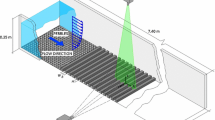Summary
This paper presents the results of laboratory experiments designed to simulate some basic process of large-scale flows interacting with obstacles, also in order to better understand details of subsynoptic disturbances that are created in the lee of large topographic features. For this event, the experimental facilities of the Istituto di Cosmogeofisica of Consiglio Nazionale delle Ricerche (CNR) were exploited, consisting in a hydraulic channel mounted on a rotating platform, along whose longitudinal axis a hemispherical obstacle was towed at various speeds. Because of the conversion of potential vorticity, the experimental results showed, as expected, the existence of a region of anticyclonic circulation, located above the obstacle; however, also an asymmetric pattern of positive vorticity located downwind of the obstacle did appear, which cannot be interpreted in terms of simple quasi-geostrophic inviscid dynamics. This behaviour is not surprising, if one considers that the real flow near the obstacle could hardly ever match the conditions of inviscid quasi-geostrophy (Ro≪1,E∼0), but was similar to that characterising the zone close to the surface of the obstacle, where inertial and viscous effects are not negligible. Finally, in order to investigate the importance of these effects on the interaction processes, simple numerical and analytical models were applied, by which the consistency of some laboratory simulations, chosen among the most significant ones, could be compared.
Similar content being viewed by others
References
Pedlosky J.,Geophysical Fluid Dynamics, 2nd edition (Springer-Verlag, New York, N.Y.) 1987, pp. 234–238.
Buzzi A. andTibaldi S.,Q. J. R. Meteorol. Soc.,103 (1977) 135.
Hide R.,Nature,190 (1961) 895.
Pedlosky J.,Geophysical Fluid Dynamics, 2nd edition (Springer-Verlag, New York, N.Y.) 1987, pp. 43–45.
Huppert H. E. andBryan K.,Deep Sea Res.,23 (1976) 655.
Alessio S., Briatore L., Ferrero E., Giraud C., Longhetto A. andMorra O.,Laboratory simulations of interaction between barotopic flows and schematic 3Dobstacles, inICEFM 94,Proceedings of the II International Conference on Experimental Fluid Mechanics,July 4–8 1994,Torino, Italy (Leurotto & Bella, Torino), 1994, pp. 169–176.
Davies P. A.,J. Fluid Mech.,54 (1972) 691.
Huppert H. E.,J. Fluid Mech.,67 (1975) 397.
Chabert d'Hierès G., Davies P. A. andDidelle H.,Laboratory studies of pseudo periodic forcing due to vortex shedding from an isolated solid obstacle in a homogeneous rotating fluid, inMesoscale/Synoptic Coherent Structures in Geophysical Turbulence, edited byJ. C. J. Nihoul andB. M. Jamart (Elsevier Science Publishers, Amsterdam) 1982, pp. 639–653.
Author information
Authors and Affiliations
Rights and permissions
About this article
Cite this article
Alessio, S., Briatore, L., Cremonini, R. et al. Laboratory simulation of inertial and frictional effects on barotropic rotating flows over and past obstacles: Comparison with simple numerical and analytical models. Il Nuovo Cimento C 18, 603–627 (1995). https://doi.org/10.1007/BF02506643
Received:
Accepted:
Issue Date:
DOI: https://doi.org/10.1007/BF02506643




